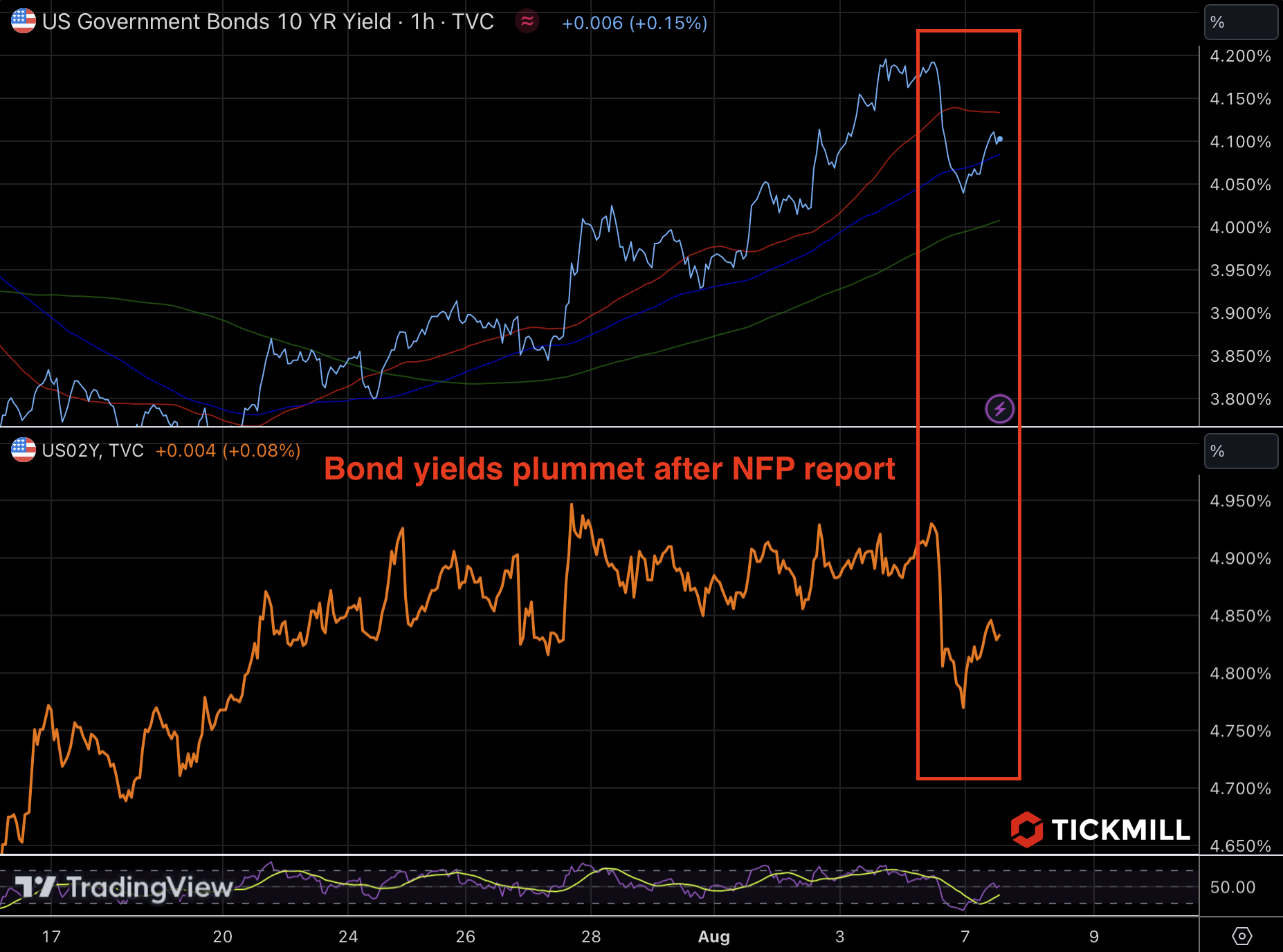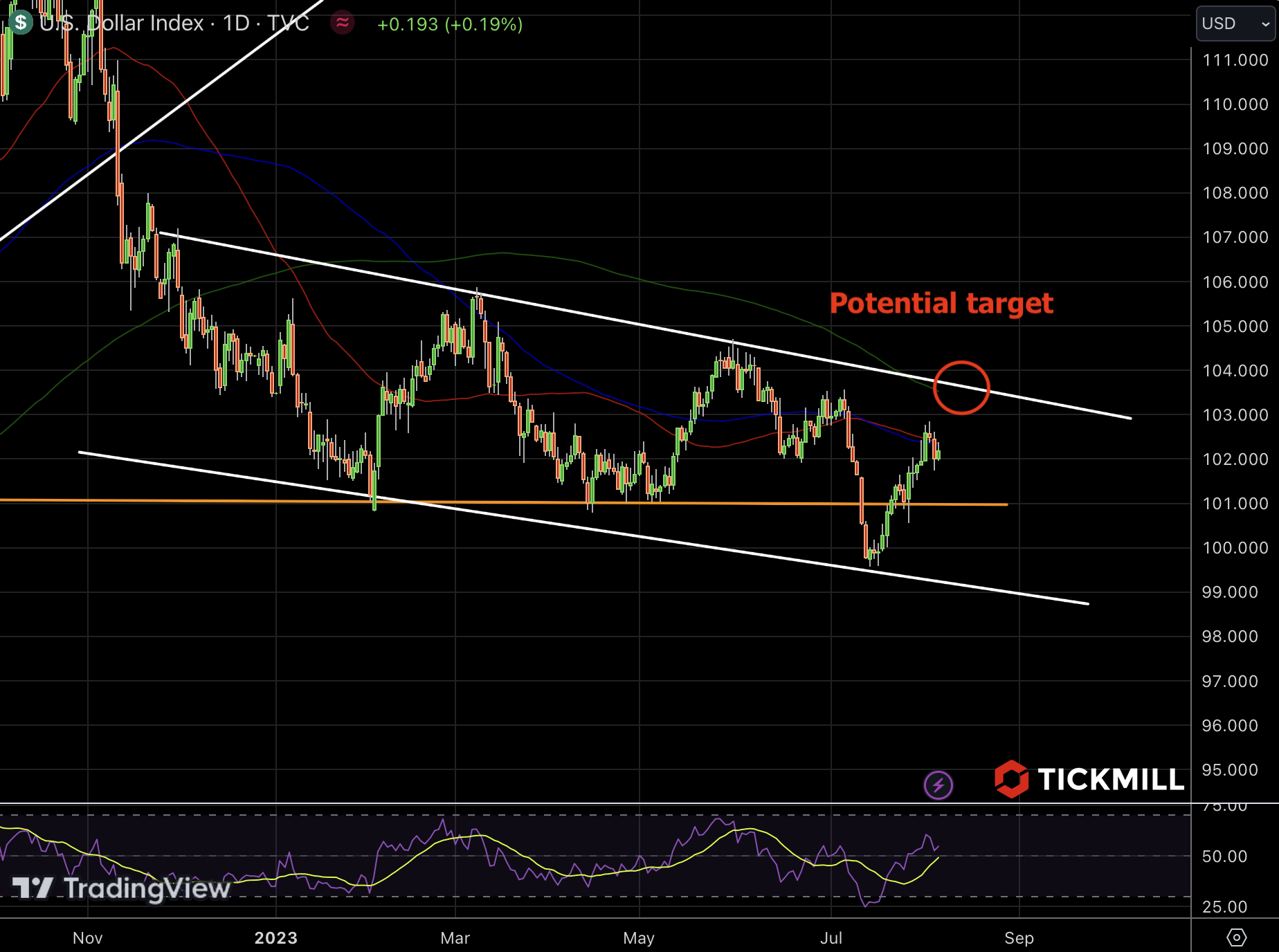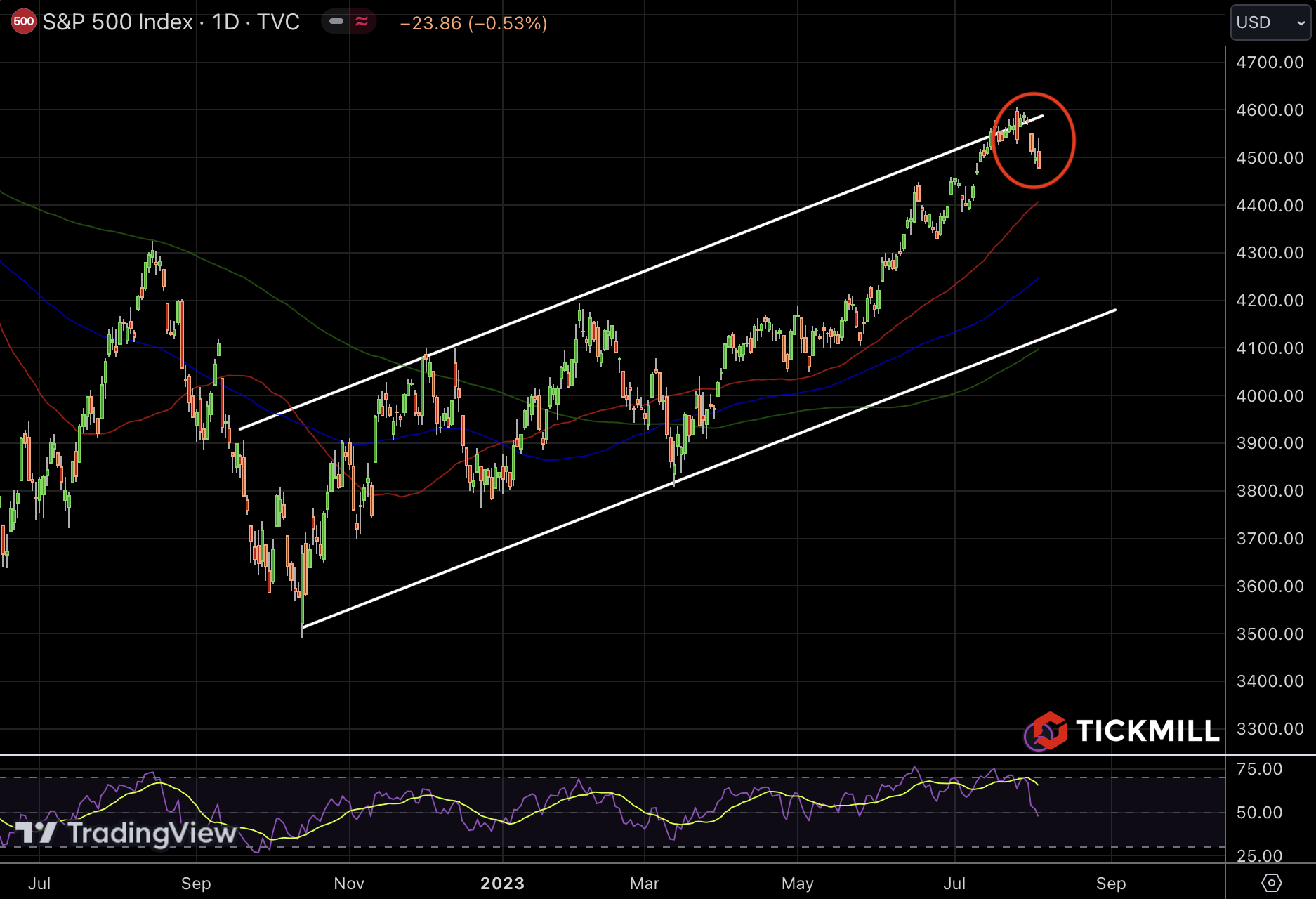tickmill-news
Well-known member
- Messages
- 393
- Likes
- 1
Dollar gains ground awaiting inflation report as US labor market shows signs of weakness
The dollar recovers on Monday after mixed NFP report released last Friday. Job gains fell short of the modest forecast of 200K, coming in at 187K, which greatly disappointed fixed income bears who was dumping bonds throughout the previous week. Yields plummeted by more than 15 basis points after the release:

However bullish reaction in bonds proved to be transitory as the inflation part of the unemployment report still indicated that the labor market retains decent potential to generate price pressures. Wage growth beat forecast coming at 0.4% MoM vs. 0.3% consensus. Unemployment also decreased to 3.5%, and as it is known, the Fed uses the inverse relationship between inflation and unemployment to shape monetary policy.
In essence, if there was any negativity, it was minor, and on Monday, the dollar started to exert pressure again, with the dollar index recovering about half of its Friday decline. The price is just a bit shy of a retest of the upper bound of the medium-term bearish channel, making the idea of shorting the dollar much more appealing:

On the chart, the zone where the dollar could renew its medium-term decline is near the 103 level.
One source of dollar support could be the U.S. stock market, which, judging by the S&P 500 chart, is clearly developing a bearish momentum:

The price rebounded from the upper bound of the ascending channel, and it had been in a downturn for the previous four days. Of course, buying interest near the key 4500 level may prevent the market to push through it easily, but in my view, a significant portion of buyers will be waiting for convergence at least with the 50-day moving average. This is roughly around the 4400 level.
A trigger for such a correction could be the U.S. inflation report this week, scheduled for release on Thursday. A decrease in core inflation from 4.8% to 4.7% is expected, along with an increase in overall inflation from 3% to 3.3%. The focus, of course, will be on core inflation, which is "cleaned" of the influence of seasonal and other short-term factors. A substantial correction of risk assets is quite likely with a combination of a weak labor market report and more resilient core inflation than expected. It might be sufficient even if inflation exceeds the forecast by 0.1% and reaches 4.8%, as in this case, asset prices will start factoring in the risks of stagflation – long-term bond yields will decrease, short-term yields will rise, and risk assets will account for the risk that the "soft landing" the Fed is diligently working towards might break at some point.
If the inflation report aligns with the forecast, there's a chance that the Producer Price Index (PPI), which will be published on Friday, will trigger a strong reaction. Last time, there was a significant response to the surprise, as PPI is a leading indicator of CPI, due to the fact that price pressure is transmitted from producer prices through costs to consumer prices.
Disclaimer: The material provided is for information purposes only and should not be considered as investment advice. The views, information, or opinions expressed in the text belong solely to the author, and not to the author’s employer, organization, committee or other group or individual or company.
High Risk Warning: CFDs are complex instruments and come with a high risk of losing money rapidly due to leverage. 75% and 72% of retail investor accounts lose money when trading CFDs with Tickmill UK Ltd and Tickmill Europe Ltd respectively. You should consider whether you understand how CFDs work and whether you can afford to take the high risk of losing your money.
The dollar recovers on Monday after mixed NFP report released last Friday. Job gains fell short of the modest forecast of 200K, coming in at 187K, which greatly disappointed fixed income bears who was dumping bonds throughout the previous week. Yields plummeted by more than 15 basis points after the release:

However bullish reaction in bonds proved to be transitory as the inflation part of the unemployment report still indicated that the labor market retains decent potential to generate price pressures. Wage growth beat forecast coming at 0.4% MoM vs. 0.3% consensus. Unemployment also decreased to 3.5%, and as it is known, the Fed uses the inverse relationship between inflation and unemployment to shape monetary policy.
In essence, if there was any negativity, it was minor, and on Monday, the dollar started to exert pressure again, with the dollar index recovering about half of its Friday decline. The price is just a bit shy of a retest of the upper bound of the medium-term bearish channel, making the idea of shorting the dollar much more appealing:

On the chart, the zone where the dollar could renew its medium-term decline is near the 103 level.
One source of dollar support could be the U.S. stock market, which, judging by the S&P 500 chart, is clearly developing a bearish momentum:

The price rebounded from the upper bound of the ascending channel, and it had been in a downturn for the previous four days. Of course, buying interest near the key 4500 level may prevent the market to push through it easily, but in my view, a significant portion of buyers will be waiting for convergence at least with the 50-day moving average. This is roughly around the 4400 level.
A trigger for such a correction could be the U.S. inflation report this week, scheduled for release on Thursday. A decrease in core inflation from 4.8% to 4.7% is expected, along with an increase in overall inflation from 3% to 3.3%. The focus, of course, will be on core inflation, which is "cleaned" of the influence of seasonal and other short-term factors. A substantial correction of risk assets is quite likely with a combination of a weak labor market report and more resilient core inflation than expected. It might be sufficient even if inflation exceeds the forecast by 0.1% and reaches 4.8%, as in this case, asset prices will start factoring in the risks of stagflation – long-term bond yields will decrease, short-term yields will rise, and risk assets will account for the risk that the "soft landing" the Fed is diligently working towards might break at some point.
If the inflation report aligns with the forecast, there's a chance that the Producer Price Index (PPI), which will be published on Friday, will trigger a strong reaction. Last time, there was a significant response to the surprise, as PPI is a leading indicator of CPI, due to the fact that price pressure is transmitted from producer prices through costs to consumer prices.
Disclaimer: The material provided is for information purposes only and should not be considered as investment advice. The views, information, or opinions expressed in the text belong solely to the author, and not to the author’s employer, organization, committee or other group or individual or company.
High Risk Warning: CFDs are complex instruments and come with a high risk of losing money rapidly due to leverage. 75% and 72% of retail investor accounts lose money when trading CFDs with Tickmill UK Ltd and Tickmill Europe Ltd respectively. You should consider whether you understand how CFDs work and whether you can afford to take the high risk of losing your money.
















































